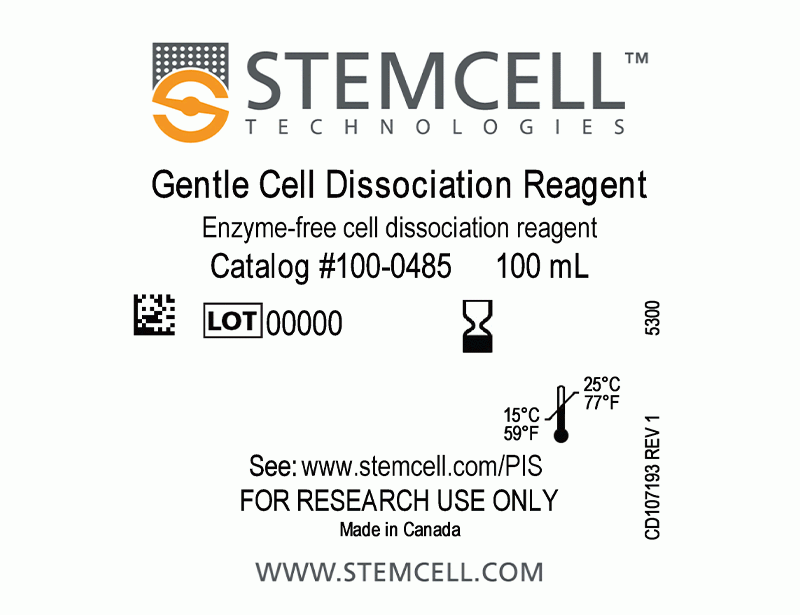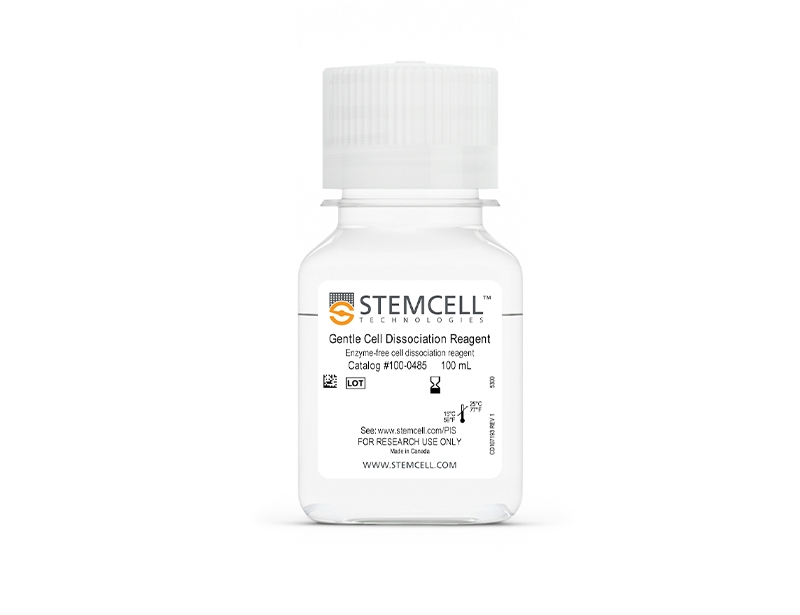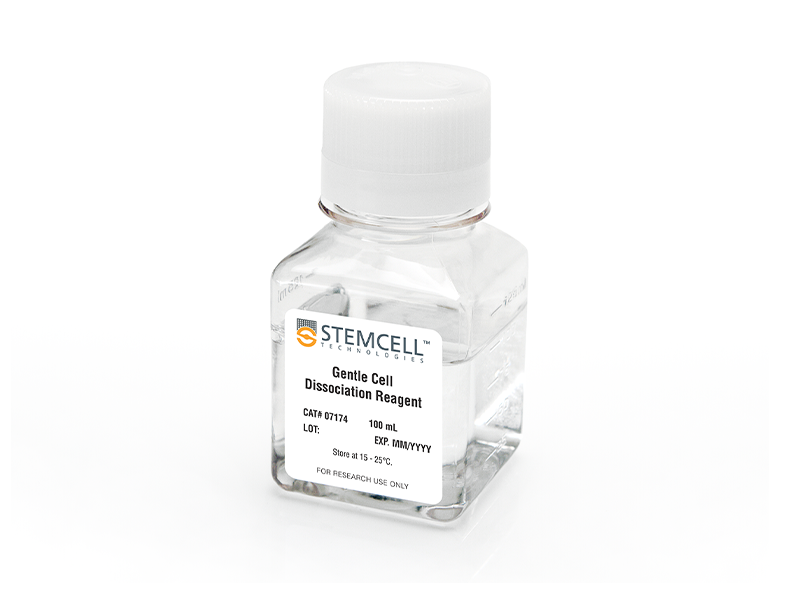Gentle Cell Dissociation Reagent
cGMP, enzyme-free cell dissociation reagent
概要
Gentle Cell Dissociation Reagent (GCDR) is an enzyme-free reagent suitable for the dissociation of human embryonic stem (ES) cells or human induced pluripotent stem (iPS) cells into cell aggregates for routine passaging or into a single-cell suspension. It is also suitable for the isolation of intestinal crypts to establish intestinal organoids, and for breaking up Corning® Matrigel® domes when passaging organoid cultures. GCDR does not contain enzymes or other proteins.
GCDR is now also manufactured following relevant cGMPs under a certified quality management system to ensure the highest quality and consistency for reproducible results.
GCDR is now also manufactured following relevant cGMPs under a certified quality management system to ensure the highest quality and consistency for reproducible results.
Advantages
• Enzyme-free and chemically defined
• Gentle on cells
• High expansion of human ES/iPS cells during routine culture
• Simple, room temperature passaging protocols
• Gentle on cells
• High expansion of human ES/iPS cells during routine culture
• Simple, room temperature passaging protocols
Subtype
Non-Enzymatic
Cell Type
Endoderm, PSC-Derived, Intestinal Cells, Pluripotent Stem Cells
Species
Human, Mouse
Area of Interest
Epithelial Cell Biology, Stem Cell Biology
技术资料
| Document Type | 产品名称 | Catalog # | Lot # | 语言 |
|---|---|---|---|---|
| Product Information Sheet | Gentle Cell Dissociation Reagent | 100-0485 | All | English |
| Product Information Sheet | Gentle Cell Dissociation Reagent | 07174 | All | English |
| Manual | Gentle Cell Dissociation Reagent | 07174 | All | English |
| Safety Data Sheet | Gentle Cell Dissociation Reagent | 100-0485 | All | English |
| Safety Data Sheet | Gentle Cell Dissociation Reagent | 07174 | All | English |
数据及文献
Publications (17)
Stem cell reports 2020 feb
iPSC-Based Modeling of RAG2 Severe Combined Immunodeficiency Reveals Multiple T Cell Developmental Arrests.
Abstract
Abstract
RAG2 severe combined immune deficiency (RAG2-SCID) is a lethal disorder caused by the absence of functional T and B cells due to a differentiation block. Here, we generated induced pluripotent stem cells (iPSCs) from a RAG2-SCID patient to study the nature of the T cell developmental blockade. We observed a strongly reduced capacity to differentiate at every investigated stage of T cell development, from early CD7-CD5- to CD4+CD8+. The impaired differentiation was accompanied by an increase in CD7-CD56+CD33+ natural killer (NK) cell-like cells. T cell receptor D rearrangements were completely absent in RAG2SCID cells, whereas the rare T cell receptor B rearrangements were likely the result of illegitimate rearrangements. Repair of RAG2 restored the capacity to induce T cell receptor rearrangements, normalized T cell development, and corrected the NK cell-like phenotype. In conclusion, we succeeded in generating an iPSC-based RAG2-SCID model, which enabled the identification of previously unrecognized disorder-related T cell developmental roadblocks.
Biosensors 2019 apr
A Novel Toolkit for Characterizing the Mechanical and Electrical Properties of Engineered Neural Tissues.
Abstract
Abstract
We have designed and validated a set of robust and non-toxic protocols for directly evaluating the properties of engineered neural tissue. These protocols characterize the mechanical properties of engineered neural tissues and measure their electrophysical activity. The protocols obtain elastic moduli of very soft fibrin hydrogel scaffolds and voltage readings from motor neuron cultures. Neurons require soft substrates to differentiate and mature, however measuring the elastic moduli of soft substrates remains difficult to accurately measure using standard protocols such as atomic force microscopy or shear rheology. Here we validate a direct method for acquiring elastic modulus of fibrin using a modified Hertz model for thin films. In this method, spherical indenters are positioned on top of the fibrin samples, generating an indentation depth that is then correlated with elastic modulus. Neurons function by transmitting electrical signals to one another and being able to assess the development of electrical signaling serves is an important verification step when engineering neural tissues. We then validated a protocol wherein the electrical activity of motor neural cultures is measured directly by a voltage sensitive dye and a microplate reader without causing damage to the cells. These protocols provide a non-destructive method for characterizing the mechanical and electrical properties of living spinal cord tissues using novel biosensing methods.
Stem cell reports 2018 JUL
Disruption of GRIN2B Impairs Differentiation in Human Neurons.
Abstract
Abstract
Heterozygous loss-of-function mutations in GRIN2B, a subunit of the NMDA receptor, cause intellectual disability and language impairment. We developed clonal models of GRIN2B deletion and loss-of-function mutations in a region coding for the glutamate binding domain in human cells and generated neurons from a patient harboring a missense mutation in the same domain. Transcriptome analysis revealed extensive increases in genes associated with cell proliferation and decreases in genes associated with neuron differentiation, a result supported by extensive protein analyses. Using electrophysiology and calcium imaging, we demonstrate that NMDA receptors are present on neural progenitor cells and that human mutations in GRIN2B can impair calcium influx and membrane depolarization even in a presumed undifferentiated cell state, highlighting an important role for non-synaptic NMDA receptors. It may be this function, in part, which underlies the neurological disease observed in patients with GRIN2B mutations.
Cell metabolism 2016 SEP
$$-Ketoglutarate Accelerates the Initial Differentiation of Primed Human Pluripotent Stem Cells.
Abstract
Abstract
Pluripotent stem cells (PSCs) can self-renew or differentiate from naive or more differentiated, primed, pluripotent states established by specific culture conditions. Increased intracellular $$-ketoglutarate ($$KG) was shown to favor self-renewal in naive mouse embryonic stem cells (mESCs). The effect of $$KG or $$KG/succinate levels on differentiation from primed human PSCs (hPSCs) or mouse epiblast stem cells (EpiSCs) remains unknown. We examined primed hPSCs and EpiSCs and show that increased $$KG or $$KG-to-succinate ratios accelerate, and elevated succinate levels delay, primed PSC differentiation. $$KG has been shown to inhibit the mitochondrial ATP synthase and to regulate epigenome-modifying dioxygenase enzymes. Mitochondrial uncoupling did not impede $$KG-accelerated primed PSC differentiation. Instead, $$KG induced, and succinate impaired, global histone and DNA demethylation in primed PSCs. The data support $$KG promotion of self-renewal or differentiation depending on the pluripotent state.
Nature Communications 2016 NOV
Somatic increase of CCT8 mimics proteostasis of human pluripotent stem cells and extends C. elegans lifespan
Abstract
Abstract
Human embryonic stem cells can replicate indefinitely while maintaining their undifferentiated state and, therefore, are immortal in culture. This capacity may demand avoidance of any imbalance in protein homeostasis (proteostasis) that would otherwise compromise stem cell identity. Here we show that human pluripotent stem cells exhibit enhanced assembly of the TRiC/CCT complex, a chaperonin that facilitates the folding of 10% of the proteome. We find that ectopic expression of a single subunit (CCT8) is sufficient to increase TRiC/CCT assembly. Moreover, increased TRiC/CCT complex is required to avoid aggregation of mutant Huntingtin protein. We further show that increased expression of CCT8 in somatic tissues extends Caenorhabditis elegans lifespan in a TRiC/CCT-dependent manner. Ectopic expression of CCT8 also ameliorates the age-associated demise of proteostasis and corrects proteostatic deficiencies in worm models of Huntington's disease. Our results suggest proteostasis is a common principle that links organismal longevity with hESC immortality.
Journal of Hepatology 2016 JUN
Stage-specific regulation of the WNT/??-catenin pathway enhances differentiation of hESCs into hepatocytes
Abstract
Abstract
Background & Aims Hepatocytes differentiated from human embryonic stem cells (hESCs) have the potential to overcome the shortage of primary hepatocytes for clinical use and drug development. Many strategies for this process have been reported, but the functionality of the resulting cells is incomplete. We hypothesize that the functionality of hPSC-derived hepatocytes might be improved by making the differentiation method more similar to normal in vivo hepatic development. Methods We tested combinations of growth factors and small molecules targeting candidate signaling pathways culled from the literature to identify optimal conditions for differentiation of hESCs to hepatocytes, using qRT-PCR for stage-specific markers to identify the best conditions. Immunocytochemistry was then used to validate the selected conditions. Finally, induction of expression of metabolic enzymes in terminally differentiated cells was used to assess the functionality of the hESC-derived hepatocytes. Results Optimal differentiation of hESCs was attained using a 5-stage protocol. After initial induction of definitive endoderm (stage 1), we showed that inhibition of the WNT/??-catenin pathway during the 2nd and 3rd stages of differentiation was required to specify first posterior foregut, and then hepatic gut cells. In contrast, during the 4th stage of differentiation, we found that activation of the WNT/??-catenin pathway allowed generation of proliferative bipotent hepatoblasts, which then were efficiently differentiated into hepatocytes in the 5th stage by dual inhibition of TGF-?? and NOTCH signaling. Conclusion Here, we show that stage-specific regulation of the WNT/??-catenin pathway results in improved differentiation of hESCs to functional hepatocytes.




